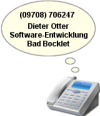Die VB Round-Funktion hat eigentlich keinen Fehler, sondern verwendet eine andere Rundungsmöglichkeit und alle anderen Funktionen, die ich im Internet gefunden hatte waren nicht geeignet. Ich brauchte eine Funktion die stur immer bei einer 5 aufrundet und drunter abrundet - und zwar egal, ob als Dezimaltrennzeichen ein Komma oder ein Punkt verwendet wird. Hab' mir dann gedacht, schreib ich selber schnell, auch 2 Übergabeparameter (bei mir als String - beliebig lange Zahlen), das wäre einmal die zu rundende Zahl und zum anderen die Anzahl der Stellen, auf die gerundet werden soll. Das Ergebnis gibt die Funktion dann wieder als String zurück. Die Funktion ist von der Spracheinstellung unabhängig, also egal ob sie eine "Amerikanische" oder "Deutsche" Kommazahl übergeben. Die Zahl wird immer korrekt interpretiert und mit dem gleichen Kommazeichen zurückgegeben. Dabei sind auch Zahlen mit 1000-er Trennzeichen erlaubt (wichtig beim Parsen). Die Kommentare hab ich in englisch geschrieben, damit sie auch jeder verstehen kann. Private Function Round(numToRnd As String, _ rndToDec As String) As String Dim strDecSymbol As String Dim tmpNumToRnd As String Dim tmpStr As String Dim i As Integer Dim digBefCom As Integer Dim digAftCom As Integer Dim cntCom As Integer Dim cntPnt As Integer Dim tmpRndToDec As Integer Dim isMinus As Boolean ' check if the strings are empty and check if ' the "RoundTo" variable is numeric If Len(numToRnd) > 0 And Len(rndToDec) > 0 And _ IsNumeric(rndToDec) = True Then ' use temp variable tmpRndToDec = rndToDec ' can't round to "minus", so round to 0 If tmpRndToDec < 0 Then tmpRndToDec = 0 ' use temp variable tmpNumToRnd = numToRnd ' check if it is a negative number isMinus = False If Left$(tmpNumToRnd, 1) = "-" Then isMinus = True ' converts the number to positive tmpNumToRnd = Right$(tmpNumToRnd, Len(tmpNumToRnd) - 1) End If ' check if is numeric If IsNumeric(Replace(Replace(tmpNumToRnd, ".", ""), _ ",", "")) = False Then ' the number is not numeric, return value is 0 ' exit function Round = 0 Exit Function End If ' set the actual decimal seperator to "" strDecSymbol = "" ' set count of the seperators to 0 cntCom = 0 cntPnt = 0 ' count comas For i = 1 To Len(tmpNumToRnd) If Mid$(tmpNumToRnd, i, 1) = "," Then cntCom = cntCom + 1 End If Next ' count points For i = 1 To Len(tmpNumToRnd) If Mid$(tmpNumToRnd, i, 1) = "." Then cntPnt = cntPnt + 1 End If Next ' check the comma/point count If cntCom > cntPnt Then If cntCom = 1 Then ' there is only one comma, also set the ' actual decimal symbol to "," strDecSymbol = "," Else ' there are several commas, also set the ' actual decimal symbol to "." because ' in this case are commas only digit ' grouping symbols strDecSymbol = "." End If If cntPnt = 0 And cntCom > 1 Then ' there are no points, also delete all ' commas because they are only digit ' grouping symbols tmpNumToRnd = Replace(tmpNumToRnd, ",", "") ' ...and set the actual decimal symbol to nothing strDecSymbol = "" End If ElseIf cntCom < cntPnt Then If cntPnt = 1 Then ' there is only one point, also set the ' actual decimal symbol to "." strDecSymbol = "." Else ' there are several points, also set the ' actual decimal symbol to "," because ' in this case are points only digit ' grouping symbols strDecSymbol = "," End If If cntCom = 0 And cntPnt > 1 Then ' there are no commas, also delete all ' points because they are only digit ' grouping symbols tmpNumToRnd = Replace(tmpNumToRnd, ".", "") ' ...and set the actual decimal symbol ' to nothing strDecSymbol = "" End If ElseIf cntCom = 0 And cntPnt = 0 Then ' there are no symbols, also set the actual ' decimal symbol to nothing strDecSymbol = "" ElseIf cntCom = cntPnt Then ' there are same number points and commas, also ' search the last symbol and set ' this one as actual decimal symbol For i = Len(tmpNumToRnd) To 1 Step -1 tmpStr = Mid$(tmpNumToRnd, i, 1) If tmpStr = "." Then strDecSymbol = "." Exit For ElseIf tmpStr = "," Then strDecSymbol = "," Exit For End If Next ' not important but cleanly, set the ' temp string to "" tmpStr = "" End If ' when exists, delete digit grouping symbols If strDecSymbol = "," Then tmpNumToRnd = Replace(tmpNumToRnd, ".", "") ElseIf strDecSymbol = "." Then tmpNumToRnd = Replace(tmpNumToRnd, ",", "") End If ' delete zeros on the begin and on the end Do While Left$(tmpNumToRnd, 1) = "0" tmpNumToRnd = Right$(tmpNumToRnd, Len(tmpNumToRnd) - 1) Loop If Len(strDecSymbol) > 0 Then Do While Right$(tmpNumToRnd, 1) = "0" tmpNumToRnd = Left$(tmpNumToRnd, Len(tmpNumToRnd) - 1) Loop End If ' set the string to 0 in case when all digits were ' zero's and deleted by the last loop If Len(tmpNumToRnd) = 0 Then tmpNumToRnd = 0 ' return the result to the function and exit function Round = tmpNumToRnd Exit Function End If If strDecSymbol = "" Then ' there is no decimal symbol, also it's not ' necessary to edit the string also first ' check if the input was negative If isMinus = True And tmpNumToRnd > 0 Then ' yes, also add a minus tmpNumToRnd = "-" & tmpNumToRnd End If ' return the result to the function exit function Round = tmpNumToRnd Exit Function End If ' count digits before and after decimal symbol For i = 1 To Len(tmpNumToRnd) If Mid$(tmpNumToRnd, i, 1) = strDecSymbol Then digBefCom = i - 1 Exit For End If Next digAftCom = Len(tmpNumToRnd) - digBefCom - 1 ' when there's nothing before and after the ' decimal symbol then set the string to 0 If digBefCom = 0 And digAftCom = 0 Then tmpNumToRnd = 0 End If ' delete decimal symbol if on the last position Do While Right$(tmpNumToRnd, 1) = "," Or _ Right$(tmpNumToRnd, 1) = "." tmpNumToRnd = Left$(tmpNumToRnd, Len(tmpNumToRnd) - 1) Loop ' there are more digits after the decimal symbol ' as the wanted digits, so start rounding If digAftCom > tmpRndToDec Then ' remove decimal symbol(s) tmpNumToRnd = Replace(tmpNumToRnd, strDecSymbol, "") ' remove unnecessary digits, leave only one more ' as wanted, temporary necessary tmpNumToRnd = Left$(tmpNumToRnd, _ digBefCom + tmpRndToDec + 1) ' check if the last digit is greater then 4 If Right$(tmpNumToRnd, 1) > 4 Then ' ...yes, also cut it (last digit) tmpNumToRnd = Left$(tmpNumToRnd, Len(tmpNumToRnd) - 1) ' ...and check the next For i = Len(tmpNumToRnd) To 1 Step -1 ' check if the actual digit is 9 If Mid$(tmpNumToRnd, i, 1) = 9 Then ' yes, also set it to 0 and go to the next digit tmpNumToRnd = Left$(tmpNumToRnd, i - 1) & "0" & _ Right$(tmpNumToRnd, Len(tmpNumToRnd) - i) Else ' no, only increase it and exit loop tmpNumToRnd = Left$(tmpNumToRnd, i - 1) & _ Mid$(tmpNumToRnd, i, 1) + 1 & _ Right$(tmpNumToRnd, Len(tmpNumToRnd) - i) Exit For End If Next ' check if all digits are 9 If i = 0 Then ' yes (loop runs to the string start), also add a 1 tmpNumToRnd = "1" & tmpNumToRnd ' increase the number of the digits before ' decimal symbol digBefCom = digBefCom + 1 End If Else ' no, the last digit is less then 5, also ' only cut the last digit tmpNumToRnd = Left$(tmpNumToRnd, Len(tmpNumToRnd) - 1) End If ' if there was only one digit and was cutted, ' then ser the string to 0 If Len(tmpNumToRnd) = 0 Then tmpNumToRnd = 0 ' add digit symbol If tmpRndToDec = 0 Then ' number should not be rounded, then do nothing tmpNumToRnd = tmpNumToRnd ElseIf digBefCom = 0 Then ' there was no digits before decimal symbol, ' also add a zero and decimal symbol tmpNumToRnd = 0 & strDecSymbol & tmpNumToRnd Else ' set the decimal symbol to the old position tmpNumToRnd = Left$(tmpNumToRnd, digBefCom) & _ strDecSymbol & Right$(tmpNumToRnd, tmpRndToDec) End If ElseIf digAftCom <= tmpRndToDec Then ' not necessary to round, so add a zero when the ' decimal symbol is on the first position If Left$(tmpNumToRnd, 1) = strDecSymbol Then tmpNumToRnd = "0" & tmpNumToRnd End If ' check if the requested number of digits are ' grater as 0 If tmpRndToDec > 0 Then ' yes, also add a decimal symbol at the ' end of the string when it is an integer If InStr(tmpNumToRnd, strDecSymbol) = 0 Then tmpNumToRnd = tmpNumToRnd & strDecSymbol End If End If ' add needed zero's to the end of the string For i = 1 To tmpRndToDec - digAftCom tmpNumToRnd = tmpNumToRnd & "0" Next End If ' check if the input was negative If isMinus = True And tmpNumToRnd > 0 Then ' yes, also add a minus tmpNumToRnd = "-" & tmpNumToRnd End If ' return the result to the function Round = tmpNumToRnd Else ' the parameter strings are not legal Round = 0 End If End Function Dieser Tipp wurde bereits 16.554 mal aufgerufen.
Anzeige
 Diesen und auch alle anderen Tipps & Tricks finden Sie auch auf unserer aktuellen vb@rchiv Diesen und auch alle anderen Tipps & Tricks finden Sie auch auf unserer aktuellen vb@rchiv (einschl. Beispielprojekt!) Ein absolutes Muss - Geballtes Wissen aus mehr als 8 Jahren vb@rchiv! - nahezu alle Tipps & Tricks und Workshops mit Beispielprojekten - Symbol-Galerie mit mehr als 3.200 Icons im modernen Look Weitere Infos - 4 Entwickler-Vollversionen (u.a. sevFTP für .NET), Online-Update-Funktion u.v.m. |
sevISDN 1.0  Überwachung aller eingehender Anrufe! Die DLL erkennt alle über die CAPI-Schnittstelle eingehenden Anrufe und teilt Ihnen sogar mit, aus welchem Ortsbereich der Anruf stammt. Weitere Highlights: Online-Rufident, Erkennung der Anrufbehandlung u.v.m. Tipp des Monats Skyfloy Chart von Microsoft und dazu noch gratis Tutorial für Microsoft Chart Controls für Microsoft .NET Framework 3.5 Neu! sevDTA 3.0 Pro  SEPA mit Kontonummernprüfung Erstellen von SEPA-Dateien mit integriertem BIC-Verzeichnis und Konto- nummern-Prüfverfahren, so dass ungültige Bankdaten bereits im Vorfeld ermittelt werden können. |
||||||||||||||||
|
Microsoft, Windows und Visual Basic sind entweder eingetragene Marken oder Marken der Microsoft Corporation in den USA und/oder anderen Ländern. Weitere auf dieser Homepage aufgeführten Produkt- und Firmennamen können geschützte Marken ihrer jeweiligen Inhaber sein. |
|||||||||||||||||


 Verbesserte Round-Funktion in VB
Verbesserte Round-Funktion in VB